On October 12, I took a day trip to a few of Minnesota's Scientific and Natural Areas (SNA) in the western part of the state. Western Minnesota is prairie land, and topographically speaking, quite boring. We in the Midwest U.S. can get excited at the smallest things, as mountains, picturesque lakes or oceans, etc. are just not outside our back doors.
First stop: Gneiss Outcrops SNA (241 acres).
Along the Minnesota river (which was gigantic in ancient times), rock out crops are many due to the removal of earth by what was then the Glacial River Warren.
Lichens seem to love this rock, and it was difficult to find any amount that was not covered with them. The following might paint me as a geologist, but really, I am (hopefully correctly) interpreting from the posted information at the site.
1. Granite gneiss.
2. Garnet-biotite gneiss. (Or might it be an igneous rock complex?) At any rate, the rocks are quite interesting here.

Comments
Richard T. Rodich
Re: Western Minnesota Scientific and Natural Areas
Thu, 10/14/2010 - 11:36pmThe Brittle prickly pear (Opuntia fragilis) here tend toward a flattish pad, reminiscent of what most people think of as prickly pear cactus. Perhaps an intergrade? Of course with winter approaching, they are shrinking down in preparation for the season, too.
Richard T. Rodich
Re: Western Minnesota Scientific and Natural Areas
Thu, 10/14/2010 - 11:55pmWhile examining the Opuntia fragilis, I noticed the familiar form of the floral skeleton of our native Fame flower (Phemeranthus parviflorus). I followed it down to the dormant plant. Phemeranthus rugospermus resides in the eastern part of Minnesota.
Richard T. Rodich
Re: Western Minnesota Scientific and Natural Areas
Fri, 10/15/2010 - 12:01amMy first encounter with this cute little Panicum sp. (or would it be Dichanthelium now?). The gray pen is 6 inches long. As I continued to walk along, I soon found that it can "explode" when in flower.
Richard T. Rodich
Re: Western Minnesota Scientific and Natural Areas
Fri, 10/15/2010 - 12:09am1. Our native form of Artemisia frigida.
2. Campanula americanus still in bloom in a woodsy part of the SNA.
The 8-10 inches of rainfall that was received in the area a week and a half ago made the marsh area impassible to the other, higher outcrops. I'll have to remember to bring my snowshoes next time...
Richard T. Rodich
Re: Western Minnesota Scientific and Natural Areas
Fri, 10/15/2010 - 12:31amNext stop, Blue Devil Valley (30 acres), named for the rare Five-lined skink that lives there. Commonly known as a Blue Devil, it has a blue tail. (I didn't see any, though.) Very different from the Gneiss Outcrops SNA, it still has the same type of rock outcrops.
1. Only about 15 miles from the Gneiss Outcrops, the Brittle prickly pear (Opuntia fragilis) here has close to globular segments. The species in the north and east of the state have definite cylindrical pads.
2. Opuntia humifusa/macrorhiza.
3. Houstonia longifolia. Just for you, Mark. I thought I had gotten a better pic, but...
4. One of our wild onions, Allium stellatum, is everywhere in this SNA. All had dried seed heads. I did find one that also had both dried heads and an immature seed head. So I was able to confirm its identity. Allium cernuum is apparently uncommon to rare in Minnesota.
Richard T. Rodich
Re: Western Minnesota Scientific and Natural Areas
Fri, 10/15/2010 - 12:48am1. A pleasantly curled Blue Grama grass (Bouteloua gracilis).
2. Wild Four o'clock (Mirabilis nyctaginea) skeleton.
3. Because these leaves were so large, I assumed them to be an anemone or ranunculus of some sort, but then I spied the unmistakeable cleistogamous seed capsule of a violet. The Bearded Birdsfoot violet (Viola ×palmata) is known to occur here, so I assume it is that.
4. And I actually found one in bloom in October!
Richard T. Rodich
Re: Western Minnesota Scientific and Natural Areas
Fri, 10/15/2010 - 2:28amAt the end of the day and another 70 miles west, I visited Yellow Bank Hills SNA. This is an 80 acre area of gravel hills surrounded by flatland as far as one can see. The topography is the result of the glaciers of the last ice age. This was by far the most austere of the three Scientific and Natural Areas. Thankfully, there were no cactus, since there were not rock outcrops. Many plants here were also at the other SNAs, but grew much smaller. Little bluestem (Schizachyrium scoparius) for example grew only 12-14 inches, when it is usually at least 2 ft.
1. One could swear it was daytime by the photo, but this was take well after the sun had dropped below the horizon, and the sunset waning. (I love digital cameras!) In the foreground is a field dominated by Side Oats grama (Bouteloua curtipendula), regularly interspersed with Little bluestem (Schizachyrium scoparius) and a mid size Liatris sp. Even here, there was much diversity.
In the background you can see one of the little knolls where a decidedly different flora existed. Here are two, which I could use some help identifying.
2. Astragalus missouriensis
3. Artemisia? Erigeron?
Calling it a day and walking back to my truck, it occurred to me how nice this is about prairies: with a clear sky you can hardly get lost in the dark!
Mark McDonough
Re: Western Minnesota Scientific and Natural Areas
Fri, 10/15/2010 - 8:59pmExcellent series Rick! It reminds us all, to just get out there and look around, there are fascinating "finds" all around us. I believe this is particularly true of native flora that is still largely overlooked. I hope you do a repeat in the spring and/or summer, or both, to show us some of these prairie plants and environment.
The last photo looks very Artemisia-esque to me, that would be my guess :)
Bouteloua gracilis is very interesting with those curling tips to the leaves.
Thanks for thinking of me and showing Houstonia longifolia; it certainly lives up to its name with much larger foliage than H. caerulea.
On Allium stellatum seed head, it has the tell-tale reddish pedicel coloration of stellatum, and a seed head more diffuse than cernuum. Thanks for showing. Did you collect seed? ;) ;)
Seeing your photo series, I am reminded that things like Opuntia grow in Minnesota, not a natural connection in my head, but great to see in this topic showing some of the variability. Would love to see these in flower, and flower variability, in summer 2011.
Reed (not verified)
Re: Western Minnesota Scientific and Natural Areas
Fri, 10/15/2010 - 9:40pmGreat Info Rick. Thanks :)
Richard T. Rodich
Re: Western Minnesota Scientific and Natural Areas
Sat, 10/16/2010 - 1:37amSeed collecting is forbidden in the SNAs, but for something like A. stellatum that really was everywhere, it seems a little silly. There is usually a good work around for seed gathering from plants that are not rare: Most SNAs are small and relatively new compared to state parks. The acreage is often donated by citizens or the Nature Conservancy. Since they aren't vast areas, usually you can go just outside the boundaries to private land and get what you want, and I've never had an owner refuse me. Many of Minnesota's Scientific and Natural Areas are not in remote locations. Blue Devil Valley abuts a housing development right in the town of Granite Falls. I was literally at the edge of people's backyards. Another 20 acre SNA in the city of Hastings is between a golf course and the Vet's Hospital. Most of it is marsh along the Mississippi River, but the little strip that runs into town is where the Snow trillium is that I had talked about on the Trillium 2010 thread.
Anyway, I had briefly thought about seed, but I already grow A. stellatum from seed from just a few counties to the east. I guess I was a little selfish, not thinking of anyone else... By the way, a few years back I reduced my stellatum stock, gave away some and fried up the rest of the bulbs for dinner. The texture was a little soft when raw, but when cooked they were a good, mild tasting onion.
Trond Hoy
Re: Western Minnesota Scientific and Natural Areas
Sat, 10/16/2010 - 2:30pmVery interesting, Rick. I had no idea of the flora of Minnesota. Have always thought of it as a state of huge areas of farmland.
Richard T. Rodich
Re: Western Minnesota Scientific and Natural Areas
Sat, 10/16/2010 - 6:08pmTrond, it is the states to the south of me that a predominantly farmland, but even they have their interesting parts. Nearly all of the prairie land in Minnesota is farmed. As you can see in the attached Minnesota pdf file, Minnesota has 3 basic ecotypes, the prairie grasslands (yellow), the deciduous woods (green) and the coniferous forests (blue-gray). The map is of pre settlement time, meaning what was before Europeans came (before year 1800). I live 25 miles east of what shows as the prairie/deciduous woods border, but really, I am right at the edge of farm country, because of the clearing of the woods for agriculture.
Lori S. (not verified)
Re: Western Minnesota Scientific and Natural Areas
Sun, 10/31/2010 - 2:03pmWell, mountains aren't the only thing... I love me a good grassland, too!
If you visit again in spring/summer, it will be interesting to see what other specialties are there.
Todd Boland
Re: Western Minnesota Scientific and Natural Areas
Tue, 12/14/2010 - 4:40pmI never realized you had 'desert' in Minnesota...those pics look like they could have been taken in Drumheller or Milk River area of Alberta.
Richard T. Rodich
Re: Western Minnesota Scientific and Natural Areas
Tue, 12/14/2010 - 6:41pmRemember too, that this is late fall. Things would be a lot greener in summer. Gneiss Outcrops and Blue Devil Valley SNAs border the Minnesota River, and there is a natural pond (most people would call it a lake) not far from Yellow Bank Hills SNA that you can see in the photo. However, Minnesota does have Weaver Dunes SNA, that contains active blowouts.
Trond Hoy
Re: Western Minnesota Scientific and Natural Areas
Wed, 12/15/2010 - 12:43amRick, a "blowout" is where the sand blows away?
We have deserts in Norway too. Some places the precipitation is less than 200mm (8inches) a year.
http://www.nrk.no/nett-tv/indeks/146755/
Richard T. Rodich
Re: Western Minnesota Scientific and Natural Areas
Wed, 12/15/2010 - 3:37pmYes, a blowout is where the sand blows away. It may shift to another location or just disperse and "disappear."
I once found a Lupinus sp. (either the white or cream flowered species) in one of these areas. It was clear that the crown was not near the surface as it normally would be. I dug in the sand for about 12 inches (31cm) down and never found where the root structure started. It was buried by the shifting sand.
I have to say, though, that this is an extremely rare phenomenon in Minnesota. Most dunes in Minnesota have been stabilized for centuries.
cohan (not verified)
Re: Western Minnesota Scientific and Natural Areas
Thu, 02/24/2011 - 4:13pmSome interesting species there, Rick, good to see!
Where I live is basically all farmland, but that does not mean all the land is cleared --a lot of it is used for grazing, and the cattle are simply turned out into the natural vegetation--wetlands, woods etc, and depending on how heavy the grazing is, there are still many native plants..
Nice that these areas have been consciously preserved, even in small chunks..
Richard T. Rodich
Re: Western Minnesota Scientific and Natural Areas
Sun, 07/22/2012 - 8:11amIn late June I took a day trip to western Minnesota near the border of South Dakota. Specifically, I wanted to explore Clinton Prairie Scientific and Natural Area, as it hosts Lilium philadelphicum (Wood Lily), one of Minnesota's native lilies.
I arrived on a very humid and sunny, 95F day that was fiercely windy. Terrible for photographing, but I think I would have melted were it not for the constant rush of fresh air.
Prairies are not exactly cornucopias of beauty for most people. In fact I am continually warning the uninitiated who want to grow a mix of wildflowers in their gardens: wildflowers tend to look like weeds until they flower. Add to that the "boring" grasses that dominate prairies, and well, you get the idea.
Clinton Prairie is 160 acres of undisturbed soils, but was managed as a hay meadow in the past. It is a shallowly rolling ground moraine of mesic to wet prairie bioms, with several small depressions just barely wet enough to support species such as Narrowleaf cattails (Typha angustifolia) and Arrowhead (Sagittaria sp.).
Leadplant (Amorpha canescens) is common in prairies throughout Minnesota. Typical growth seems herbaceous to the untrained eye, but in one part of the prairie, they grew taller than I have ever seen in the state (third photo).
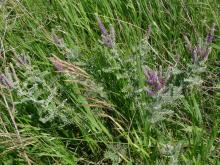
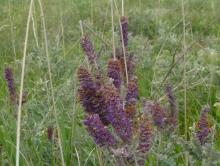
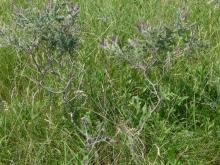
Canada Anemone (Anemone canadensis) can be a thug in gardens, but here it has its niche, growing well in certain more moist parts, but absent in most of the prairie.

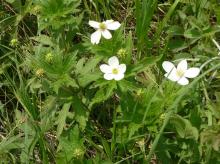
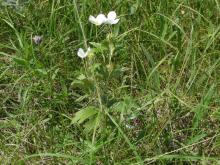
Thimbleweed (Anemone cylindrica) grew in the drier parts as singular plants.
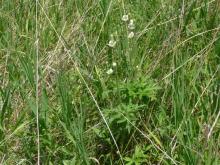
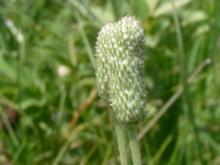
Prairie Dogbane (Apocrynum sibiricum) looks almost like it could be an Asclepias sp., but the inflorescence structure is not umbellate.
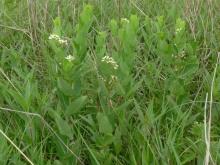
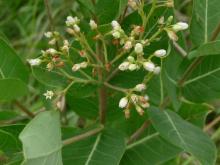
Richard T. Rodich
Re: Western Minnesota Scientific and Natural Areas
Sun, 07/22/2012 - 8:25amStill at Clinton Prairie.
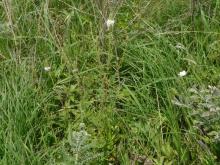
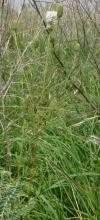
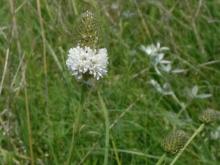
Prairie clover grows to handsome clumps in the garden, but is usually just one to several stems in the wild. I did not find Purple Prairie clover here, but
White Prairie clover (Dalea candida) was common.
Pale coneflower (Echinacea pallida)
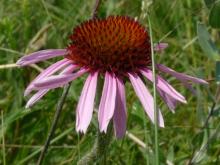
Not to be confused with Giant hyssop which has a licorice smell, this is Wild Licorice (Glycyrrhiza lepidota).
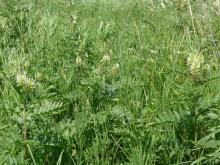
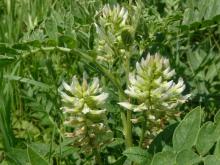
Sweetclovers are terribly invasive species in prairies, and can easily grow six feet or more. Here, Yellow sweetclover (Melilotis officinalis). Yellow and White sweetcolvers are biennial. The dead "brush" you see in the background in this pic (more prominent in other photos) is sweetclover. Not thinking about this segment of a forum post, I had avoided photographing the large and typically unsightly dead material. In parts of the prairie, it was so thick that it was difficult to walk through.
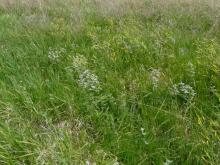
Maximilian Sunflower (Helianthus maximiliani) is our latest blooming native sunflower. Every year one wonders if there will be time enough for it to bloom and seed, but it always does.

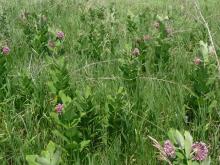
Second pic: Common milkweed (Asclepias syriaca).
Richard T. Rodich
Re: Western Minnesota Scientific and Natural Areas
Sun, 07/22/2012 - 8:40amIn Clinton Prairie, the Wood lily (Lilium philadelphicum) does well. The flowers are huge in comparison to the leaf area. Leaves are two inches long and cloth only the uppermost one-third of the stem. There are not even any vestigial nodes on the bottom two-thirds that are typical of most other Lilium species of similar habit. Lilium philadelphicum that I see on rock outcrops in the boreal parts of northern Minnesota bare leaves almost to the base of the plant.
All the dead "sticks" in these photos, even in the distance, is the invasive sweetclover.
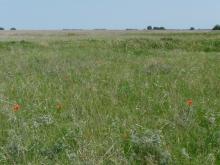
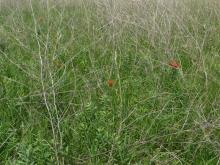
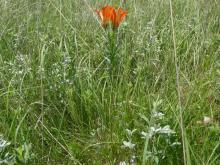
Richard T. Rodich
Re: Western Minnesota Scientific and Natural Areas
Sun, 07/22/2012 - 8:51amContinuing in Clinton Prairie,
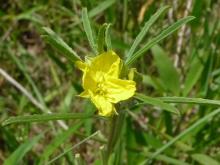
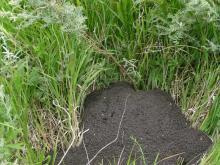
Whorled loostrife (Lysimachia quadriflora) just opening, and not yet assuming its characteristic nodding position. Rich prairie soil, freshly dug by a gopher.
Showy Blue lettuce (Mulgedium(Lactuca) pulchellum)

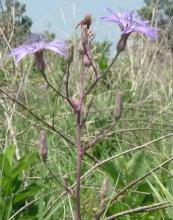
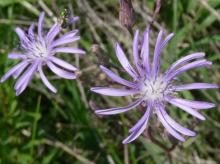
Silverleaf scurfpea (Pediomelum(Psoralea) argophyllum). Like artemesias with leaves covered with a whitish tomentum, these scurfpeas are heavily clothed with very reflective whitish hairs.

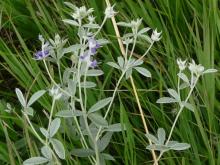
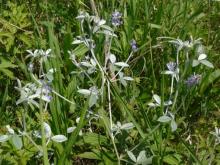
White meadowsweet (Spiraea alba) and what appears to be a hybrid of native Rosa spp. that are supposedly common in the area.
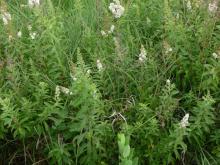
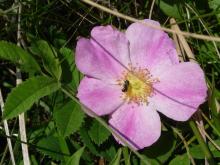
Richard T. Rodich
Re: Western Minnesota Scientific and Natural Areas
Sun, 07/22/2012 - 9:10amLast pics for Clinton Prairie:
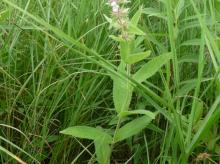

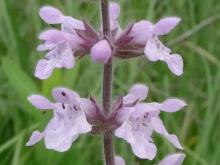
Marsh Hedge nettle(Stachys palustris)
Teucrium canadensis?
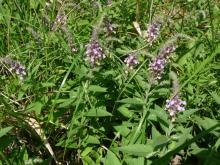
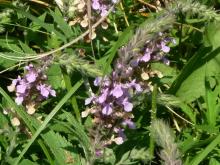
Mountain Death camas(Zigadenus elegans) just ending. Impossible to find if it were not flowering, but the seed pods are quite distinctive.
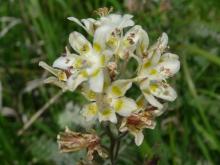
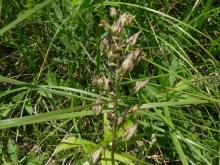
Trond Hoy
Re: Western Minnesota Scientific and Natural Areas
Sun, 07/22/2012 - 9:29amRick, I would grow a whole prairie if I had room for it! However with limited space I have to be satisfied with some nice species.
I grow the Canada Anemone and it spreads slowly with my permission ;D
The sweetclover is a weed here to but only in warm areas with deep soil.
Interesting stuff you tell us.
Richard T. Rodich
Re: Western Minnesota Scientific and Natural Areas
Sun, 07/22/2012 - 11:37amMore pics from wild western Minnesota in other areas near the South Dakota border:
Missouri milkvetch (Astragalus missouriensis)
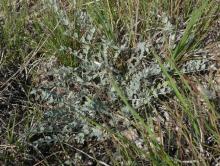
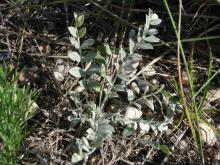
Missouri milkvetch habitat: the south, east and north sides of the topmost knolls, 1-5ft. below the summits in gravel substrate.
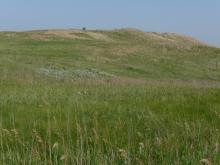
Prairie larkspur (Delphinium carolinianum), and its seed pods. Not exactly a well formed inflorescence, but the hodgepodge of flowers is fairly normal for the species here.


Pale coneflower (Echinacea pallida)
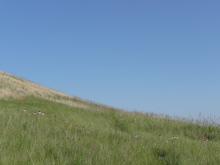
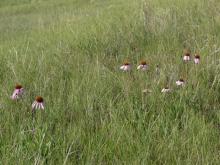
Little bluestem (Schizachyrium scoparius). We had practically no snow last winter. What you see is last season's seed heads. Second pic, Little bluestem and Prairie fleabane.
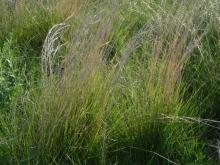
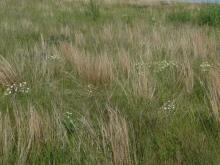
Lori S. (not verified)
Re: Western Minnesota Scientific and Natural Areas
Sun, 07/22/2012 - 11:39amI really enjoyed the prairie tour, Rick! Thanks for taking us along! How tall does Amorpha canescens typically get? I grew a bunch from seed this year, and this time, they are still surviving... (and if they are successful, I'll have to weed many out.) Stachys palustris is very showy, and I like the Teucrium also. Gorgeous lily photos!
cohan (not verified)
Re: Western Minnesota Scientific and Natural Areas
Sun, 07/22/2012 - 12:33pmNice stuff, Rick!
Lots of familiar species as well as many that don't make it this far north or into the mixed woods zone..
Sweet clover is common here too, though mostly restricted to roadsides, so it doesn't have a major impact on native species; the true clovers are much more bothersome..
The Stachys is a fave here, along with both Anemones; lots of cylindrica wild in my yard, and I'm encouraging some big patches- I've realised its lack of showy flowers is more than made up for with the seedheads giving nice interest/texture all winter; Stachys and A canadensis I plan to introduce to my yard in places where they can go to town, the Stachys I think is just as aggressive as the Anemone..
Love some of the real prairie plants that I mostly don't have- Psoralea, Amorpha, etc..
I'm sure you are right that people aren't clearly envisioning true prairie when they think of 'wild' gardens, and most wild plants have a much shorter season than garden forms- for a small city lot you would need to carefully think out your sequence of blooming etc, or you could have an empty lot look much of the year.. here, I have enough space (and selective vision) that I just don't look at those areas that are past their prime (before is less of an issue)..
However, the time I find native plants at their best (compared to exotics) is the late late season- very few flowers of course, because they know what they are doing, but I find once frosts have begun, native plants age into winter much more gracefully than exotic garden plants which may be flowering incongruously amid the ruin or just be a prematurely blackened mess, or halfway between those! while the natives are gone to golds and browns and seedpods!
Richard T. Rodich
Re: Western Minnesota Scientific and Natural Areas
Sun, 07/22/2012 - 12:58pmThey usually seem to stay around 2.5ft. I've grown Amorpha canescens from seed too, but I don't have any in my garden. Now that I think about it, could it be grazing that keeps them short? Never really thought about it before... and never investigated the plants to see if they had ever been "pruned". I would have noticed the uncharacteristic growth pattern if they were grazed to a foot or so, but if they were eaten to the ground, I would never know. Amorpha might be tasty to deer and moose... Clinton Prairie is surrounded by miles of farmland, and it is conceivable that grazing animals do not venture there. The tall Leadplants were only in one small part of the 160 acres, and shorter specimens of the species were scattered everywhere. The prairie is managed with fire as part of the regime. Perhaps they have not set fire to that one small part?
i couldn't agree with you more! And I thought I was the only seed pod freak (I mean enthusiast) here... ;D
Richard T. Rodich
Re: Western Minnesota Scientific and Natural Areas
Sun, 07/22/2012 - 1:04pmLast bunch of photos:
More Prairie fleabane (Erigeron strigosus)
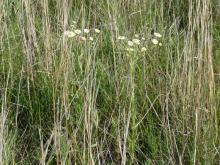

Long-headed coneflower (Ratibida columnifera)
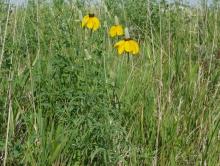
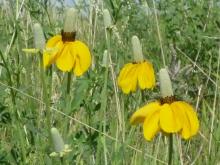
Hoary Vervain (Verbena stricta) and an excellent specimen of Wooly plantain (Plantago patagonica). It seemed to like the relative lack of competition. Now that you know what you are looking for, Trond, you can pick out a few leaves from this previous photo, too: http://nargs.org/smf/index.php?action=dlattach;topic=299.0;attach=34838;...

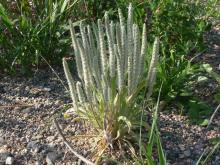
In some gneiss outcrops:
Prairie fameflower (Phemeranthus parviflora) and Long-leaf bluet (Houstonia longifolia)
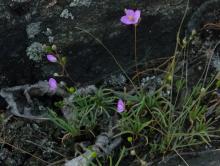

Ball cactus (Escobaria vivipara) and Fragile cactus (Opuntia fragilis)
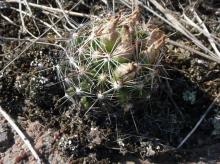
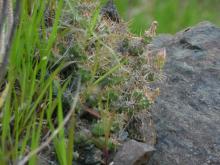
And the last 2 posts I uploaded 9 and 10 photos all at once, and it worked great! I think our behind the scenes IT experts are hard at work... still! (We can't thank you all enough!)
cohan (not verified)
Re: Western Minnesota Scientific and Natural Areas
Sun, 07/22/2012 - 11:47pmOf course not all plants are as interesting at every stage, but I like every stage from emerging leaf buds to flower buds to full growth to fresh seed, ripe seed, dry seed, dying/fall leaf colour, to dried stems and overwintering seedheads, empty or otherwise, etc... of course the growing season is so short, that for months there is nothing to look at but dried stems...lol... But even in Toronto, I would be so fond of photographing bare tree limbs over winter that I was almost sad to see them leaf out in spring..
Love the Plantago! Phemeranthus is cute too..
Trond Hoy
Re: Western Minnesota Scientific and Natural Areas
Mon, 07/23/2012 - 2:36amThanks, Rick, I can see it! The woolly plantain is a striking plant even without blazing colours! You have shown a lot of interesting plants and landscape, Rick, thank you. Some of the plants are wellknown garden plants here and you can get them in every nursery.
However, my favorite would be the Prairie fameflower (Phemeranthus parviflora), totally unknown till now!
Richard T. Rodich
A short stop in "wild"
Mon, 08/25/2014 - 9:06pmA short stop in "wild" Minnesota: a rock ledge along a road just outside of Granite Falls in the western part of the state. 19 August
A view from the ledge, of the ledge
There has been a whole lot of extra rain this year, and I never realized how prolific Allium stellatum was until I saw them all blooming.
Artemisia frigida, and Plantago patagonica seed heads and a Panicum sp.
It was mostly and overcast day and late morning, so no Phemeranthus parviflorus were blooming. But they have never looked so fat and robust (again, with the abundance of rain). And same with the lichens, this one, one of the leafy types.
And more miscellaneous pics of the natural rock garden, with P. parviflorus, Salaginella rupestris, Opuntia fragilis and Bouteloua gracilis.
I don't know what this little purple flowered plant is, but it is interesting.
Selaginella rupestris
And I always seem to find something new, no matter where I go or how often I go there: Euphorbia cyathophora. It's also in the center of the last habitat photo.
Richard T. Rodich
The same rock ledge, I
Wed, 09/10/2014 - 9:24amThe same rock ledge, I returned Sept 7, hopefully for seed. After reading up on Euphorbia cyathophora, and getting how "quickly" it produces seed, I may have missed some, but I can't be sure. At any rate, the explosive cases weren't exploding now, as I firmly, but gently grasped the pods. So no seed.
Oodles of Phemeranthus parviflorus capsules, but relatively few were ripe, and many already shattered. I did get some seed, though. Plants grew significantly larger than most years, with the excess rain this season. Dried Plantago patagonica at the left in the first pic. I wanted seed because the Minnesota ((or Minnesota region?) species type has larger and much more colorful flowers with 2-3 more and showier stamens than the ones from the (south)western USA.
Cymous inflorescence structure of Phemeranthus showing deciduous sepals. Phemeranthus parviflorus seed. (1mm graph paper.)
The first time I've ever found Oxalis violacea in the wild. It's not supposed to be a rare plant in Minnesota. Never at the right place at the right time, I guess. And this time, it was one of the not so common years that it rebloomed in the fall (and with no leaves). Only one open (and damaged flower), but that made the colorfully tipped sepals more evident.
Allium stellatum continues to bloom, and Atemisia frigida (left) is beginning, with Artemisia campestris center stage.
Mirabilis nyctaginea with Phemeranthus parviflorus and Bouteloua gracilis in foreground. And a couple views.
Richard T. Rodich
I stopped at a nearby area to
Wed, 09/10/2014 - 8:54amI stopped at a nearby area to view the opuntia there. Most experts agree that this is Opuntia macrorhiza.
It is certainly different from the Opuntia humifusa that grows only six miles away.